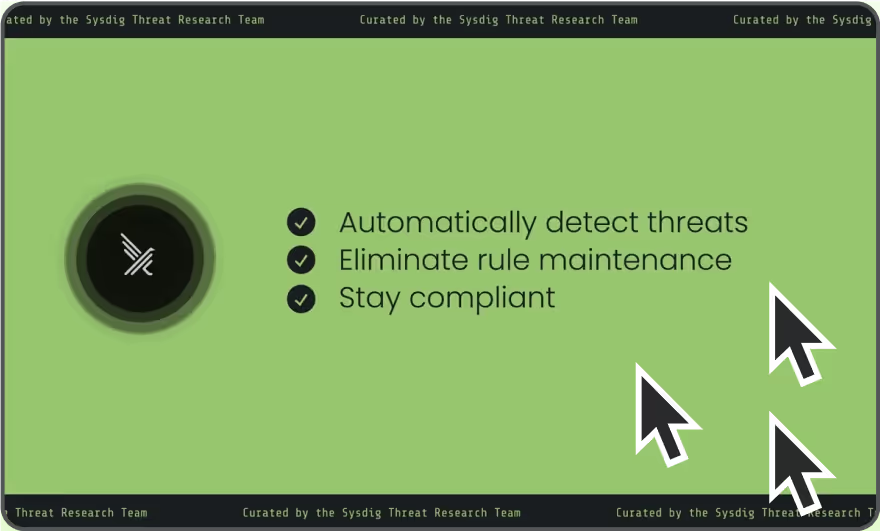
Falco Feeds extends the power of Falco by giving open source-focused companies access to expert-written rules that are continuously updated as new threats are discovered.

Cloud attacks unfold in seconds. Threat actors already use automation and AI to move faster than security teams can respond. Traditional AI tools can summarize and prioritize mountains of alerts, but they don’t reason or take action. Agentic AI changes that.
AI is transforming how we work, from research to code generation. Yet, most AI tools were designed for convenience, not defense. Writing, summarizing, and automating tasks isn’t the same as protecting a dynamic cloud environment.
Real protection demands AI that understands context, reasons about business impact, and makes autonomous decisions.
Security teams face relentless pressure to find, prioritize, and fix risks quickly and accurately. They can’t afford to make a mistake. At Sysdig, we believe that agentic AI should work hand in hand with security teams to speed up discovering and mitigating risk in the cloud.
Cloud security demands more than what traditional AI offers
Traditional AI for security has fallen short. It doesn’t reduce the cognitive burden facing defenders at scale. Too often, AI security tools fall into one of these three buckets:
- Chatbot-wrapped documentation: Provide access to manuals, but offers no risk triage assistance.
- Static machine learning model: Trained on past data can leave AI tools blind to new and emerging risks.
- Scripted playbooks: Only able to help in very specific scenarios, which can’t keep up in dynamic environments.
These AI tools may help in isolation, but they don’t ease the pressure that defenders face. With thousands of alerts and limited time, teams are left triaging instead of truly reducing risk.
Security teams don’t need another dashboard or chatbot; they need a teammate. Agentic AI works beside them, understanding context and automating the busywork so defenders can focus on strategy, not triage.
How agentic AI helps security align with business
Security has often been seen as a checkbox, a way to prove compliance, not accelerate innovation. But in reality, it’s a critical enabler of speed, trust, and business confidence.
What organizations need out of their security is the reassurance and trust that business-critical assets and applications remain protected, help with decision-making, and not acting as a roadblock to forward progress and innovation.
When security aligns with business strategy, it becomes a growth enabler. Agentic AI amplifies that alignment. It helps secure the cloud and protect assets, freeing up the team to discover opportunities and assist in keeping the business forward-looking.
This is what makes agentic AI so powerful for cloud security. It can reduce the cognitive burden on security teams, while scaling up risk prioritization and problem-solving. Agentic AI understands the context behind an attack or risk, which enables it to determine whether this issue impacts the business and should be raised to humans.
For example, if a Linux vulnerability is discovered but the organization’s production environment runs on Windows, agentic AI recognizes the risk as non-critical and deprioritizes it. Rather than producing yet another alert for teams to spend time researching, the agentic AI lowers the risk prioritization as something for another day.
By approaching cloud security this way, teams can focus on what matters most: keeping critical workloads protected while empowering the business to move faster.
Sysdig Sage is the future of cloud security
Sysdig SageTM represents a new approach: agentic AI that understands your environment, reasons through complex signals, and acts alongside defenders.
Agentic AI shifts security teams from reactive to responsive. It reduces alerts on theoretical risks and instead surfaces risks that are real and exploitable. Security teams get the reasoning, evidence, and context behind each risk, so they understand the issue and fix it quickly.
Through multi-step reasoning, Sysdig Sage breaks down complicated tasks into smaller, more manageable steps to quickly assist defenders. For example, one agent could identify a suspicious log-in attempt, have another agent perform recursive investigation loops to determine if this activity is benign or truly suspicious, while another agent collects the evidence so human defenders can make the final judgment call.
Sysdig Sage provides audit-ready reports that contain vulnerability management metrics, so security teams can confidently communicate with the CISO and board that there is a reduction in business-critical risks.
Agentic cloud security reduces risks in real time
Limited security budgets and exhausted teams often result in poor risk prioritization and missed vulnerabilities. Agentic AI acts as an intelligent teammate that scales expertise, continuously prioritizing what’s critical and filtering out what’s not. This enables security teams to determine critical risks are categorized and prioritized while freeing teams up to focus on strategic security initiatives.
This is the future of cloud defense: faster, smarter, and built for the realities of the cloud. Download the Agentic Cloud Blueprint to learn more.


